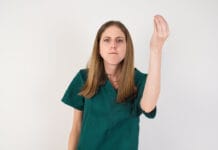When I celebrated my fifth year as a licensed dental hygienist, I had already practiced clinically in four different states. At one point, I was maintaining four active hygiene licenses, which included paying four different renewal fees, juggling four different continuing education requirements, and keeping current on rules and regulations from four different dental boards.
Some of you may be nodding your head enthusiastically right now, empathizing with my journey and understanding the unspoken struggles that come with a highly mobile lifestyle. However, most dental hygienists have not considered what it takes to restart one’s career by practicing in a different area of the country. Thanks to advances in technology and changes in generational ideals, more and more dental hygienists are choosing to uproot their careers and follow opportunities wherever they may lead.
Unfortunately, occupational license portability regulations for dental hygienists have not yet kept up with these changing times.
Have you filled out …?
To help you understand what license portability currently entails, the following is a snapshot of just some of the tasks state dental boards require a dental hygienist to complete in order to obtain a license in their state:
- Contact the state’s dental governing board
- Complete a lengthy application with multiple notarized documents
- Pay an application fee in addition to a biennial licensure fee
- Take a jurisprudence exam via mail or at an official testing center (retake, if necessary)
- Acquire sealed transcripts from accredited hygiene school and other post-high school education
- Provide certification of having passed clinical and national dental hygiene licensure examinations
- Request letters of good standing from each state in which active licenses are held, including non-dental licenses
- Provide proof of current CPR certification through approved providers
- Provide proof of mandatory CE courses required for the state
- Submit a comprehensive work history, including address and contact information for all previous employers
- Submit multiple character references
- Submit a signed and dated passport-sized photograph
- Provide personal information and supporting documents regarding past or existing medical conditions, citizenship status, student loans, child support, and more
- Undergo a criminal background check, which may include fingerprinting
- Complete an in-person interview with the dental board
- Submit additional fees and documents for any additional expanded functions (i.e., restorative duties, local anesthesia, nitrous oxide inhalation, ITR, laser, direct access permits, etc.)
- Potentially retake and successfully pass clinical boards1-4, 7
In my personal journey, this process of applying for initial licensure and receiving an active license was often filled with dread and anxiety. While waiting anywhere from five months to a year for the process to be completed, I had plenty of time to ask questions: Why do I have to get a new license even though I am already a successful clinical provider just across the state line? How long will the application process take this time? What will I do if they don’t grant me a license? Is this even worth the headache?
Each relocation was accompanied by a significant career setback. Quite honestly, I weighed whether it was worth continuing a dental hygiene career. While waiting, I’d begin what would become a futile attempt at the interview process, knowing I’d be lucky if someone were to hire a hygienist whose license is pending. I often considered working retail or other low-paying jobs in order to earn some income, no matter how nominal.
Things worked out, though, and I’m happily entering my 15th year in dentistry. In retrospect, I now fully comprehend how those first five years shaped my professional identity. Although my nomadic days have come to an end, I recognize the license portability struggle is still very real for many colleagues.
Trends in Professional Licensure
So, the question remains: Why is occupational license portability an issue in the first place, and how is it changing, if at all?
According to the American Dental Hygienists’ Association (ADHA), professional licensure helps protect the public from unqualified individuals and unsafe practice.8 Similarly, state-based occupational license portability rules were once thought to help protect the public’s health and safety.
Over the years, interstate compacts between states and model laws have been enacted. These efforts are attempts to diminish the unintended negative effects of these license portability rules. Dental governing bodies have also attempted to alleviate some of the burdens by granting licensure by credentials. Currently, 46 states provide this pathway that allows dental professionals who hold active licenses in other states to obtain a license without having to complete their professional examinations over again.9
For dental hygienists who are considering obtaining another state’s license, the good news is that there has been a recent uptick in dialogue among stakeholders and legislators. One significant advancement occurred earlier this year when the governor of Arizona signed a bill to allow the state to become the first to universally recognize out-of-state licenses.6 Additionally, a dental licensure compact has recently been proposed, the first of its kind for dentists and dental hygienists.5
But is this enough? Hygienists within social media circles have argued that advancements in license portability for dental hygienists should be a top priority for advocacy groups and have called for more support from the ADHA and other professional associations.
Thanks to outdated occupational portability laws, dental hygienists who wish to work in another state face a long and burdensome application process, often leading to unnecessary career setbacks.
Whether or not this directly applies to your career, I urge you to join the dialogue and advocate for continual advancements in this area. Begin a discussion with colleagues in your network and reach out to health coalitions, dental boards, professional associations, and other allies. By working together, we have the ability to improve occupational license portability, advancing our profession not only for ourselves but for dental hygienists everywhere.
References
- State Board of Dentistry. Pennsylvania Department of State. Retrieved from https://www.dos.pa.gov/ProfessionalLicensing/BoardsCommissions/Dentistry/Pages/default.aspx
- New Jersey Division of Consumer Affairs. The State of New Jersey. Retrieved from https://www.njconsumeraffairs.gov/den/Pages/default.aspx
- Oregon Board of Dentistry. Retrieved from https://www.oregon.gov/dentistry/Pages/index.aspx
- Minnesota Board of Dentistry. Retrieved from https://mn.gov/boards/dentistry/
- Masters, R. Occupational License Portability and the Dental Profession. Access. July 2019: 16-17. Retrieved from http://pubs.royle.com/publication/?m=21156&l=1#{%22issue_id%22:599806,%22page%22:18}
- Bill History for HB2569. Arizona State Legislature. Retrieved from https://apps.azleg.gov/BillStatus/BillOverview/72039
- https://www.adha.org/resources-docs/75116_State_Licensure_Credentials_Endorsement_Chart.pdf
- https://www.adha.org/licensure
- https://www.ada.org/en/education-careers/licensure/licensure-dental-students/licensure-by-credentials












